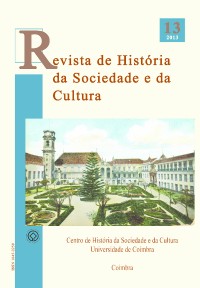Please use this identifier to cite or link to this item:
https://hdl.handle.net/10316.2/39396| Title: | As romarias no planalto beirão, desde os inícios do século XVIII | Authors: | Silva, José Manuel Azevedo e | Keywords: | Popular pilgrimages;Beira Plateau;Temples;Marian worship;Other forms of worship;Romarias;Planalto beirão;Templos;Culto mariano;Outros cultos | Issue Date: | 2013 | Publisher: | Centro de História da Sociedade e da Cultura | Abstract: | Neste estudo, começamos por nos situar nos princípios do século XVIII e por captar
a rede de santuários e de outros tipos de templos do planalto beirão dedicados à Virgem
Maria, nas suas múltiplas invocações, constantes do Santuário Mariano, de Frei Agostinho
de Santa Maria. O autor publicou, em volumes separados, os santuários respeitantes às três
dioceses que então (como hoje, com o ajustamento dos seus limites) estão presentes neste
espaço geográfico. Seguindo a ordem alfabética, temos as dioceses de Coimbra, da Guarda e
de Viseu. Este foi o seu único critério organizativo. Tendo a plena consciência de podermos
incorrer nalguma imprecisão, face à divisão administrativa dos concelhos de então e de
agora, esforçámo-nos por “arrumar” os templos (santuário, capela, ermida ou igreja matriz)
que abrigavam a imagem da Virgem Maria, dentro da jurisdição de cada um dos actuais
17 municípios do planalto beirão. Abordaremos também, ontem como hoje, os cultos não
marianos, a simbiose entre o sagrado e o profano e os principais santuários e romarias em
honra e glória do Senhor, bem como o sentido das preces ou o cumprimento de promessas
dos crentes aos santos e santas da sua devoção. In this article, we start by placing ourselves at the beginning of the 18th century and mapping, in the so called Planalto Beirão (the Beira Plateau), the network of shrines and other types of temples dedicated to the Virgin Mary, in Her multiple denominations, collected from Santuário Mariano by Agostinho de Santa Maria. This author, in three separate volumes, made an inventory of the shrines located in the three dioceses which, at that time, (as well as today, with some adjustments of their limits), were situated in the mentioned geographical area. Following the alphabetical order, we have the dioceses of Coimbra, Guarda and Viseu. This was the author’s only organizational criterion. Being fully aware that we can incur some inaccuracy, given the administrative division of the municipalities of that time and nowadays, we tried to assign to each temple (shrine, chapel, small chapel or parish church) that housed the image of the Virgin Mary, a place within the jurisdiction of each of the existing 17 municipalities of the Beira Plateau. We also approached – in the past and nowadays – non-Marian worship, the symbiosis between the sacred and the profane and the main shrines and pilgrimages in honour and glory of the Lord, as well as the meaning of prayers and the fulfilment of promises that believers made to the saints of their devotion. |
URI: | https://hdl.handle.net/10316.2/39396 | ISSN: | 1645-2259 2183-8615 (digital) |
DOI: | 10.14195/1645-2259_13_14 | Rights: | open access |
| Appears in Collections: | Revista de História da Sociedade e da Cultura |
Files in This Item:
| File | Description | Size | Format | |
|---|---|---|---|---|
| as_romarias_no_planalto_beirao.pdf | 3.67 MB | Adobe PDF |  |
Items in DSpace are protected by copyright, with all rights reserved, unless otherwise indicated.
